Best Practices for Overseeding Your Lawn
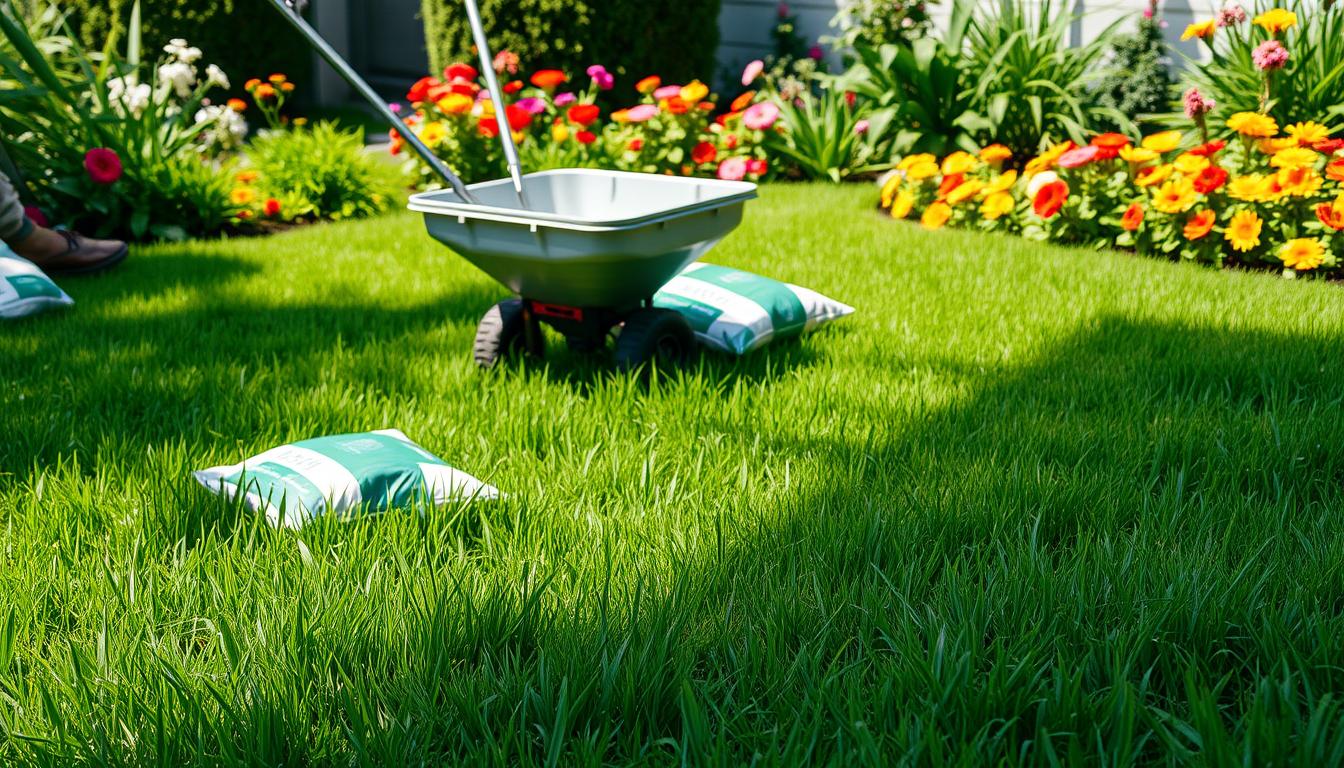
Did you know that overseeding can boost the desirable grasses in your lawn by up to 50%?
Overseeding is a quick and affordable way to make your lawn look better. It’s perfect for homeowners who want to improve their outdoor spaces. Before you start, you need to figure out why your lawn looks thin.
Is it because of poor drainage, soil pH problems, or not enough nutrients? Once you’ve fixed these issues, you can get ready to overseed. Start by cutting your grass to 1.5 to 2 inches. This helps the new seeds grow well.
The best time to overseed depends on where you live and what kind of grass you have. Cool-season grasses like Kentucky bluegrass do best in late summer or early spring. Warm-season grasses should be overseeded in mid-spring for a greener lawn.
Key Takeaways
- Overseeding can boost desirable grasses by up to 50%
- Address underlying lawn issues before overseeding
- Mow existing lawn to 1.5-2 inches before overseeding
- Time overseeding based on grass type and location
- Use the right grass seed for your lawn’s conditions
What is Overseeding and Why is it Important?
Overseeding is a simple way to spread fresh grass seed over your lawn. It’s a low-cost method that can make your lawn look lush and green. By adding new grass seed, you can fill in bare spots and make your lawn thicker and healthier.
A well-kept lawn can make your home look better and increase its value. Overseeding is a great way to revive a tired lawn without a full lawn thickening makeover. It’s a key tool for keeping your outdoor space beautiful and welcoming.
The Benefits of Overseeding
- Fills in bare patches and thin areas of the lawn
- Thickens the overall grass density for a lush, carpeted appearance
- Improves the lawn’s resistance to drought, heat, diseases, and pests
- Enhances the overall aesthetic and curb appeal of your property
- Can be a cost-effective alternative to a complete lawn renovation
Understanding the value of overseeding and using it in your lawn care can make your lawn the talk of the town.
Identify and Address Underlying Issues
Before you start overseeding, find out why your lawn is thin. It might be because of poor drainage, wrong soil pH, or not enough nutrients. Fixing these problems first will help your new grass seed grow well.
Addressing Poor Drainage
Does your lawn hold water after rain or watering? This could mean you have poor drainage. Waterlogged soil can kill your grass roots, making your lawn thin and unhealthy. To fix this, try aeration, adjusting the soil slope, or installing French drains.
Balancing Soil pH
The pH of your soil affects your lawn’s health. Grass grows best in slightly acidic soil, with a pH between 6.0 and 7.0. If your soil is too alkaline or acidic, it can stop your grass from getting the nutrients it needs. A soil test can show you the pH level, and you can use lime or sulfur to adjust it.
Correcting Nutrient Deficiencies
Not enough nitrogen, phosphorus, or potassium can also make your lawn look bad. A soil test can find any nutrient imbalances. Then, you can use the right fertilizers or soil amendments to fix these problems before overseeding.
By fixing the underlying lawn issues, you’ll make overseeding more effective. Your lawn will become lush and healthy, lasting for many years.
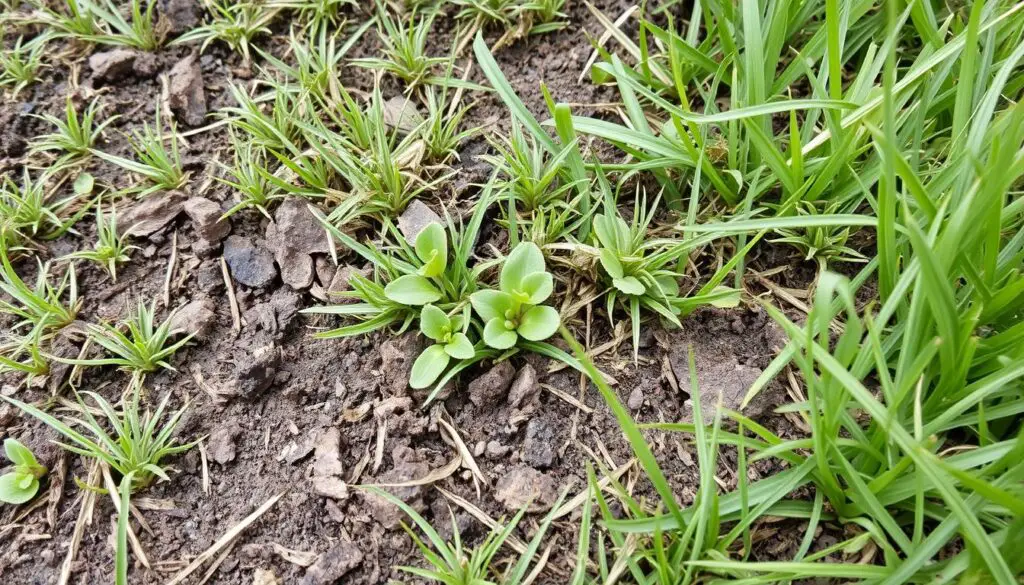
Choose the Right Time for Overseeding
Timing is key when overseeding your lawn. The best time varies based on your grass type – cool-season or warm-season. Knowing the best overseeding seasons for your grass is crucial for a successful lawn.
Cool-Season Grasses
For cool-season lawns like Kentucky bluegrass or fine fescue, overseed in late summer or early fall. The soil is warm, but the air is cooler, perfect for new seed germination. This way, the new grass grows strong before winter.
Warm-Season Grasses
Warm-season grasses, like Bermuda or zoysia, do best in mid-spring. The soil and air are warm, ideal for new seedlings to grow. This timing helps the new grass blend well with the existing turf.
Even if you miss the best time, you can still overseed. For cool-season grasses, try early spring. For warm-season, late spring is better.
When overseeding, avoid using herbicides for at least 30 days beforehand. This prevents seed germination issues. By timing your overseeding right, you’ll get a lush, healthy lawn that lasts.
Overseeding Tips
Overseeding your lawn can make it look new again. But, you need to prepare well for it to work. First, cut your lawn short, to 1.5 to 2 inches. This helps the seeds reach the soil better. Then, clean up the clippings to avoid blocking the seeds.
For small spots, a leaf rake works great. It gently prepares the soil and removes debris. But, for bigger lawns, renting a core aerator or vertical mower is better. These tools break up the soil and remove thatch, making it perfect for new grass.
- Mow the lawn short (1.5 to 2 inches) to improve seed-to-soil contact
- Bag or rake up clippings to prevent interference with new grass seed
- Use a leaf rake to rough up small areas or rent a core aerator or vertical mower for larger lawns
Preparing your lawn well is crucial for overseeding success. You want a seedbed that lets the new grass touch the soil directly. This increases its chance of growing well. With good preparation, your lawn will soon be green and beautiful, impressing everyone around.
“The secret of getting ahead is getting started.” – Mark Twain
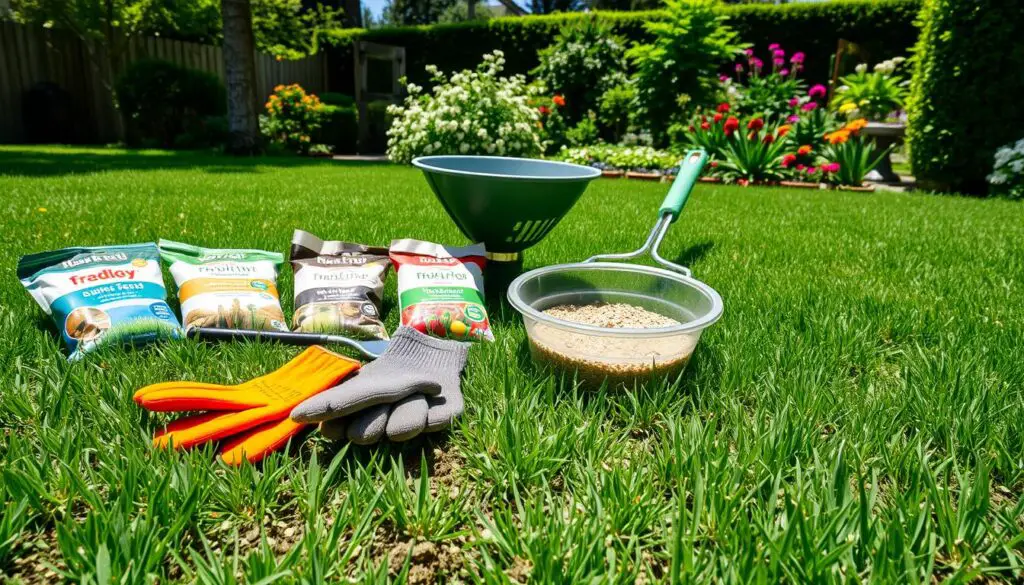
Select the Appropriate Grass Seed
Choosing the right grass seed is key for a lush lawn. Pick a seed that matches your lawn’s type. For cool-season lawns, Kentucky bluegrass or fine fescue works well. Warm-season lawns do best with Bermuda or Zoysia.
Seed suppliers have mixes for different conditions. These include sun, traffic, and drought tolerance. You’ll need 4 to 8 pounds of seed per 1,000 square feet.
Timing is important. Overseed cool-season grasses 45-60 days before frost. Warm-season grasses do well in late spring or early summer. In mild winters, overseed warm-season grasses in spring.
| Grass Type | Ideal Overseeding Time | Seed Quantity | Seed Cost |
|---|---|---|---|
| Cool-Season | Fall | 4-8 lbs per 1,000 sq ft | $40-$150 per 50 lbs |
| Warm-Season | Late Spring/Early Summer | 4-8 lbs per 1,000 sq ft | $40-$150 per 50 lbs |
Always choose a high-quality seed blend. It should have different species for better disease resistance and look. With the right grass seed selection, your lawn will thrive.
Spread the Seed
Spreading grass seed is key in overseeding. The size of your lawn determines the best method. You can use hand-spreading for small areas or spreaders for larger ones.
Hand-Spreading for Small Areas
Hand-spreading is good for small overseeding jobs. Just scatter handfuls of seed over the area. Make sure it’s spread out evenly, then rake it into the soil.
This helps the seed get in touch with the soil. It’s important for the seed to grow well.
Spreaders for Larger Lawns
For big lawns, drop or broadcast spreaders are better. Drop spreaders work well in tight spaces. They drop seed as you move the machine.
Broadcast spreaders are great for big, open areas. They spread seed in a wide pattern, covering more ground fast.
It’s important to spread the seed evenly. This prevents bare spots and helps your lawn grow thick and healthy.
“Proper seed-to-soil contact is essential for successful overseeding. Be sure to lightly rake the seed into the top ¼ inch of soil.” – Sam, author of The Mowers Guide
Fertilize the Newly Seeded Lawn
After spreading the grass seed, it’s key to use a lawn starter fertilizer. This gives new seedlings the nutrients they need for quick growth and strong root establishment. Don’t use “weed and feed” products, as they can harm new grass growth.
When picking a starter fertilizer, choose one with more phosphorus. This nutrient helps build a strong root system. Some good choices are:
- GreenView 2129800 with an NPK ratio of 10-18-10
- Scotts Turf Builder with an NPK ratio of 24-25-4
- Pennington UltraGreen with an NPK ratio of 22-23-4
Make sure to follow the package instructions for the right amount. You should apply lawn starter fertilizer at 0.5 to 1 pound of nitrogen per 1,000 square feet.
Proper fertilizing helps your lawn grow strong and healthy. Mix the fertilizer into the soil well. Also, avoid applying it when it’s very hot to prevent loss.
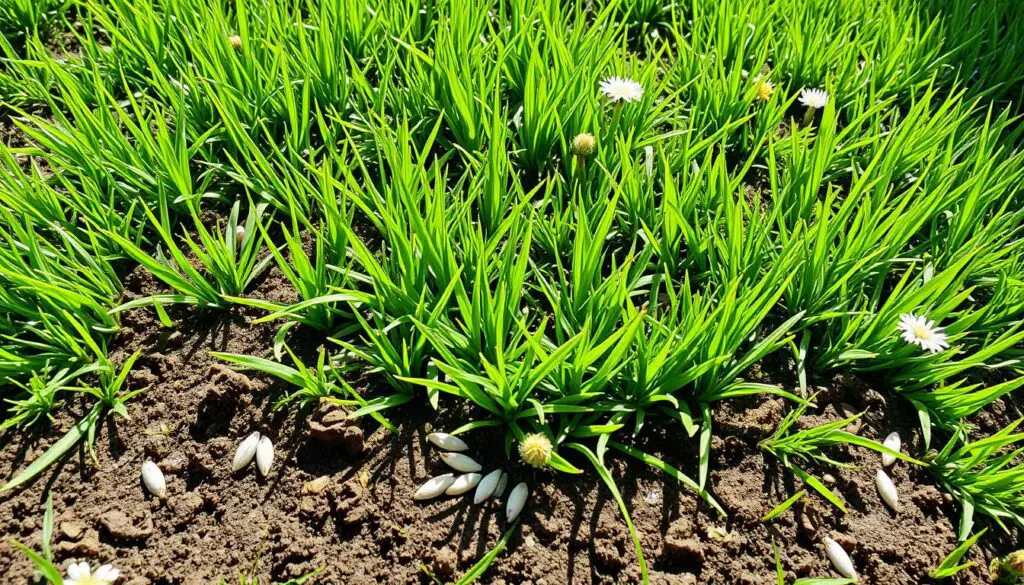
“Fertilizing a newly seeded lawn is crucial for its success. The right lawn starter fertilizer will provide the necessary nutrients to support the new grass growth and root establishment.” – Sam, author and lawn specialist
Water Regularly
Watering new grass seed properly is key to success. After spreading the seed and fertilizer, water the lawn deeply. Then, water the seeded area lightly once or twice a day until the new grass is as tall as the existing lawn.
Keep the soil moist but not too wet. Watering in the morning, before 10 a.m., helps prevent water loss. Watch for signs of too much water, like puddles or spongy soil, and adjust your watering schedule.
Maintain Consistent Soil Moisture
Grass seed germinates in 7-14 days, with an average germination rate of around 80% for fall seeding. Spring seeding rates are slightly lower, at about 75%, due to weeds and other factors.
Water the seeded area twice daily for the first four weeks. This keeps the soil moist and promotes new grass establishment. After four weeks, reduce watering by 25%.
Use the tuna can method to measure water. Ensure the lawn gets 1 to 2 inches of water per week, based on soil type. Sandier soils may need closer to 2 inches.
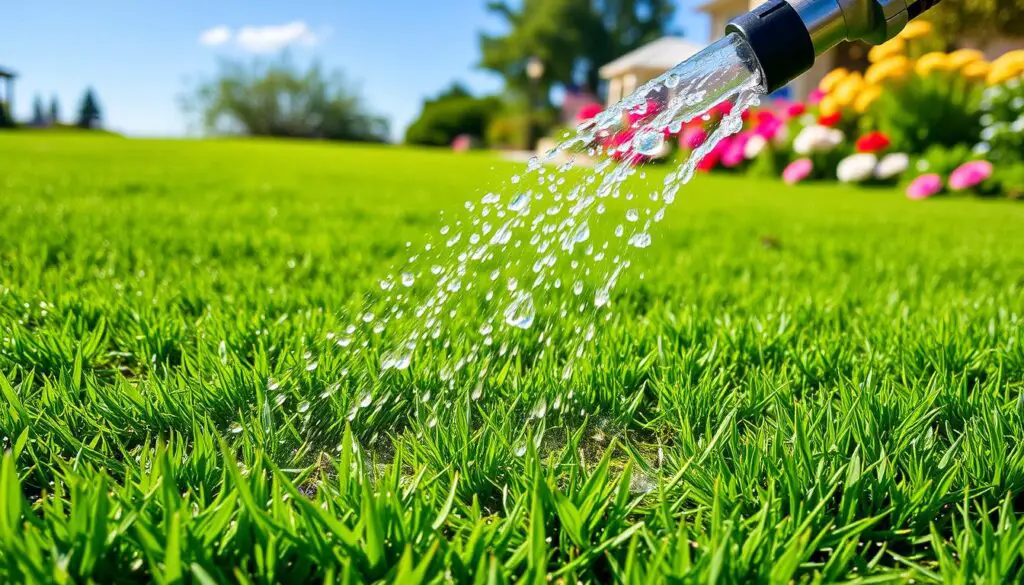
Proper watering is vital for new grass establishment. By following these tips and keeping the soil moist, you’ll have a lush, healthy lawn.
Minimize Traffic and Mowing
To help your new grass seed grow well, it’s key to reduce foot traffic and mowing in overseeded spots. Try not to walk on the lawn too much. Wait to mow again until the new grass is as tall as the old grass. This lets the young seedlings grow strong roots and blend well with the rest of the lawn.
Here are some tips to protect your overseeding:
- Try not to walk on the overseeded spots too much. Walking can pack the soil and hurt the new grass seedlings.
- Wait to mow again until the new grass is as tall as the old grass, usually 4-6 weeks after overseeding. This helps the new grass grow deep roots.
- When you start mowing the overseeded spots, use the highest setting to avoid cutting the new grass too short. Slowly lower the mowing height over weeks to match your usual lawn height.
By reducing traffic and mowing, you’ll help your overseeded lawn grow thick and healthy. It will blend well with your existing lawn.
Remember, grass blades only live for a month or two. So, it’s important to protect the new seedlings during this critical time. With patience and care, your overseeding will lead to a lush, vibrant lawn. It will handle regular foot traffic and mowing well.
Maintain Your Overseeded Lawn
After the new grass grows in, you can go back to your usual lawn care routine. Keep mowing at the right height and fertilize with a special turfgrass fertilizer 6 weeks after it germinates. This will help your lawn get thicker and look better over time.
Overseeding every few years keeps your lawn lush and healthy. It fills in bare spots and stops weeds. In northern areas, overseed 45 days before the first frost. In southern areas, overseed when nights are below 65 degrees.
“A thin layer of one-quarter of an inch or less of enriched soil should be added over existing grass during overseeding.”
Watering is key for a strong root system. Water your lawn 2 to 4 times daily for the first 2 weeks. Then, water once or twice per day for the next 2 weeks. After a month, go back to your usual watering schedule.
Wait 2 to 3 weeks before mowing, and start with the mower’s highest setting. Avoid walking or driving on your lawn for 2-3 weeks to let the new grass grow.
Keep up with mowing, fertilizing, and watering to make your overseeded lawn thrive. Overseeding regularly is easy and keeps your lawn looking great for years.
The Benefits of Overseeding
Overseeding your lawn does more than just fill in bare spots. It makes the turf thicker and healthier. The new grass plants push out weeds, making the lawn stronger. Overseeding also boosts the lawn’s ability to handle drought, heat, diseases, and pests, keeping it green all year.
In warm-season grass areas, overseeding with cool-season ryegrass in fall creates a lush winter lawn. It not only makes my lawn look better but also cuts down on the need for harmful chemicals. This makes my lawn more eco-friendly.
Overseeding thickens the turf and encourages deeper roots. This helps prevent soil erosion and keeps moisture in, saving water. The benefits of overseeding are many, from better looks and disease resistance to saving the environment and money on lawn care.
FAQ
What is overseeding and why is it important?
What are the common causes of thin turf that should be addressed before overseeding?
When is the best time to overseed my lawn?
How do I properly prepare my lawn for overseeding?
How do I choose the right grass seed for overseeding?
How do I properly spread the grass seed?
Do I need to apply fertilizer after overseeding?
How should I water the newly overseeded lawn?
How do I manage foot traffic and mowing on the overseeded area?
What are the long-term benefits of overseeding my lawn?
Source Links
- https://www.bhg.com/tips-for-overseeding-a-lawn-7094455
- https://scotts.com/en-us/how-to/how-to-overseed-a-thin-lawn.html
- https://www.ryanturf.com/why-overseed/
- https://www.lawnstarter.com/blog/lawn-care-2/how-to-overseed-lawn/
- https://www.pennington.com/all-products/grass-seed/resources/overseeding-a-key-to-beautiful-lawns
- https://www.simplygreenlawncare.com/blog/lawn-overseeding-guide/
- https://www.estatehub.io/articles/a-guide-to-grass-renovation-and-overseeding
- https://www.lawnstarter.com/blog/lawn-care-2/when-to-overseed-spring/
- https://www.lawndoctor.com/blog/how-to-overseed-your-lawn-when-is-the-right-time/
- https://www.bobvila.com/articles/how-to-overseed-a-lawn/
- https://www.lawn-care-academy.com/overseeding-lawns.html
- https://lawnlove.com/blog/benefits-of-overseeding/

